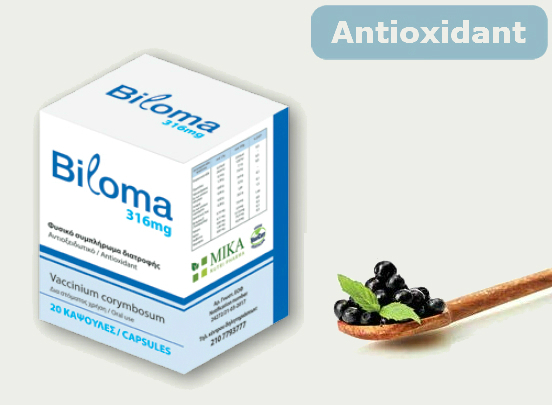
Biloma is a new product with blueberry extract, scientifically known as Vaccinium corymbosum. The blueberry is rich in antioxidant vitamins A, C, E and B-carotene, sugars, magnesium potassium, phosphorus, mineral acids, minerals, pectin and fiber. The oral intake of Biloma ensures immediate activation of its beneficial properties.
Contributing to the fight against aging-related diseases.
Its powerful antioxidant activities and flavonoids contained act against many forms of cancer, including skin cancer. Its polyphenols combat the enzymes responsible for destroying collagen in the skin and prevent the appearance of fine lines.
An ally in the maintenance of collagen in the skin.
Biloma is also rich in ellagic acid, a substance which, in addition to its additional individual antioxidant effects, suppresses excess melanin production, while stimulating the production of new modellastin. It further contributes to the health of the skin, keeping it shiny, naturally suppressing the factors leading to premature aging, through the reconstruction of damaged elastin fibers.
A study by Tufts University in the US classifies blueberry as the number one fruit (among 60 fruits tested systematically) in antioxidant and anti-aging properties – almost 40% more than red wine.
Protection of keratinocytes from UVA & UVB rays
Clinical and epidemiological studies have shown that consumption of flavonoids in foods and beverages can contribute significantly to protection against ultraviolet radiation. Phenolic compounds act as protection shields and help reduce damage caused by UVA & UVB rays in keratinocytes (1). In particular, the Vaccinium corymbosum extract decreases UVB-induced cytotoxicity and genotoxicity and UVB-induced lipid peroxidation (1). In addition, it reduces redox potential in cells, UVA-induced apoptosis, while it generally contributes significantly to the reduction of oxidative stress and apoptotic markers in cells exposed to radiation (1).
Ellagic acid, a key component of Biloma, has been the subject of many uncontrolled observation and in-vitro studies. These studies have concluded the following:
- Suspends tyrosinase. This enzyme is responsible for melanin synthesis. In particular, in-vitro proved that pigmentation on the skin was less after taking ellagic acid (2).
- Improves skin elasticity. Ellagic acid reduces the expression of MMP-2 and MMP-9 enzymes responsible for elastolysis. Thus, it improves elastogenesis and protects against the proteolytic degradation of modulolastin and elastin (3,4)
- Helps revitalize the skin. The antioxidant effect of ellagic acid protects against skin damage by protecting skin DNA and inhibiting ultraviolet apoptosis (5).
- Anti-inflammatory action. In a study (6), ellagic acid has been shown to inhibit production of IL-1β and IL-6 cytokines produced by white blood cells as a reaction to inflammation.
- https://www.ncbi.nlm.nih.gov/pubmed/24577051
- Shimogaki H, et al. In vitro and in vivo evaluation of ellagic acid on melanogenesis inhibition. IntJ Cosmet Sci. (2000)
- Losso JN, et al. In vitro anti-proliferative activities of ellagic acid. J Nutr Biochem. (2004)
- Jimenez F, et al. Ellagic and tannic acids protect newly synthesized elastic fibers from premature enzymatic degradation in dermal fibroblast cultures. J Invest Dermatol. (2006)
- Hseu YC, et al. Ellagic acid protects human keratinocyte (HaCat) cells by aging UVA-induced oxidative stress and apoptosis through upregulation of HO-1 and Nrf-2 antioxidant genes. Food Chem Toxicol. (2012)
- Bae JY, et al. Dietary compound ellagic acid alliviates skin wrinkle and inflammation induced by UV-B irradiation. Der Dermatol. (2010)
